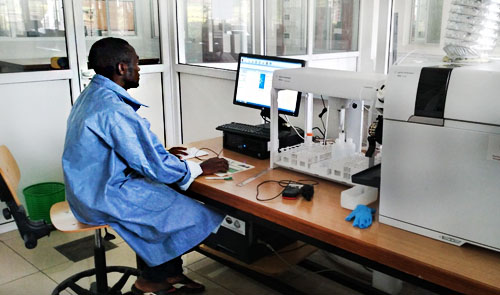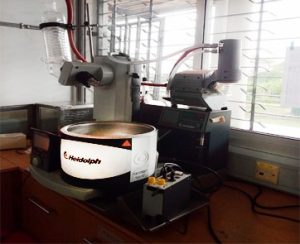
The NM-AIST Laboratory Services provides students with total practical skills from their theoretical background base in a conducive scientific and engineering environment. Students and Researchers are attached with a highly qualified with enough experiences laboratory personels. According to the laboratory management policy, laboratory is headed by Laboratory Manger, assisted with Scientists of various professional disciplines in functional units. Currently, researchers/students are allowed to use these facilities from 8:00 am to 4:00 pm Monday to Friday. Many research works in various disciplines are carried out in our laboratory; this is one of the achievement, making us to be one of the leading university in science, engineering and technology. However, our research policy which is guided by the University vision also directing our where we are supposed to go in a scientific world. In that way, research conducted at NM-AIST laboratory will fit into the overall short and long terms plans of the institution in order to bring about a holistic and coordinated impact national wise.
The laboratory department is there to fulfil the institution’s vision and mission as well as to provide a good, quality and a state of art laboratory facilities to serve the local and foreign researchers. NM-AIST aims to become a research- intensive institution and this is reflected in the objectives of the University as stated in the Institution charter.Soil analysis.
main objective is to offer the broad range of analysis for soil biology, soil chemistry, soil physics and geology. It provides services to students, researchers, research projects and other clients (individuals, governmental and non- governmental organizations).
The laboratory aims at high quality data that can be used in developing and transferring sustainable and environmentally sound soil and plant management practices that will improve crop productivity that will lead to economically viable agriculture.
quality data that can be used in developing and transferring sustainable and environmentally sound soil and plant management practices that will improve crop productivity that will lead to economically viable agriculture.
The laboratory is equipped with high technology equipment for soil and plant survey, soil and plant analysis, which include Inductively coupled plasma- Mass spectrometry (ICP-MS), CHNOS Analyzer, scanning electron microscopes, stereo microscopes, storage facilities e.tc., The laboratory is accredited by the Tanzania board of standards, it uses protocols and procedures which are safe and reliable during the process of soil and plant analysis.
Microbiology
Microbiology is a natural science that deals with microorganisms such as bacteria, fungi, protozoa, algae, and viruses. It is concerned with the nature and properties of these organisms, their effects on humans and the environment, and how they can be exploited to provide useful products.
with the nature and properties of these organisms, their effects on humans and the environment, and how they can be exploited to provide useful products.
Microbiology department offers services to researchers, students and other client. We analyze microbial samples from various sources such as food stuffs, soil, plants, water, and animal samples.
The tests performed include:
1. Culture for different bacteria, fungus
2. Media preparation
3. Microscopic diagnosis eg:- gram staining
4. Sterilization process/ autoclaving
5. Colony counting
Bioprospecting and Food and nutrition.
Microbiology department offers services to researchers, students and other client. We analyze microbial samples from various sources such as food stuffs, soil, plants, water, and animal samples. It involves a systematic and organized a scientific investigation which are used in searching for a useful products derived from bio resources/environmental resources including plants, microorganisms, and animals purposely for academic and society matters. This laboratory process leading to the discovery of new products.
offers services to researchers, students and other client. We analyze microbial samples from various sources such as food stuffs, soil, plants, water, and animal samples. It involves a systematic and organized a scientific investigation which are used in searching for a useful products derived from bio resources/environmental resources including plants, microorganisms, and animals purposely for academic and society matters. This laboratory process leading to the discovery of new products.
The following are services offered in bioprospecting laboratory:
1. On-site sample(s) collection performed with a very well qualified laboratory personels.
2. Sample storage in High Tech Equipment/Technology.
3. Sample Treatment/Preserved with High Technology to stay for a long time.
4. Preparation of various samples for analysis performed with a very well qualified personels and High Tech Equipment.
5. Culturing of Organisms and Isolation of specific Compounds.
6. Separation of various compounds using high Tech Machines/Technology.
7. Analysis of Aflatoxins in food product
8. Analysis of Vitamins from food product
9. Analysis of physical parameters in food substances
10. Analysis of phytochemical components
11. Analysis of pesticides
| Package Type | Subcategory of price list | Type of Equipment to be Used | Price |
|---|---|---|---|
| Water Quality Analysis |
|
|
|
| Soil Analysis |
|
|
|
| Material Analysis |
|
|
|
| Microbiology Analysis |
|
|
|
| Molecular Biology Analysis |
|
|
|
| Food and Nutrition Analysis |
|
|
|
| Tissue Culture Analysis |
|
|
|
(i) NM-AIST students and staff have access to use the laboratory from 8:00am to 4:00pm Monday to Friday – standard working hours
(ii)Students working in the laboratory must be affiliated to academic staff at the department, and they have the responsibility to make such agreements in advance.
(iii)The laboratory is also available to external researchers during the aforementioned hours as approved and communicated by head of department of the respective school and acknowledged by the laboratory manager
(iv)At all times when the laboratory is in use, laboratory personnel(s) must be available, for assistance and control
(v)Any exception granted to the aforementioned laboratory access guideline, must be justified and abide to the guideline for laboratory access.
(vi)Whenever access is required before and/or after the standard working hours, it MUST be communicated in advance to the responsible personnel and be approved following the proper chain of command, i.e. approved by head of department and facilitated by human resources for over time/extra duty documentation, appropriate compensation for Laboratory personnel is a MUST.
These individuals/groups may fall in four categories as defined below;
a) NM-AIST students: Masters, PhD, volunteers and field attached students.
b) NM-AIST employees: permanent and temporary
c) External users: Researchers/ Collaborators
d) Visitors




 Visit Today : 86
Visit Today : 86 Visit Yesterday : 78
Visit Yesterday : 78 This Month : 634
This Month : 634 This Year : 634
This Year : 634 Total Visit : 22206
Total Visit : 22206